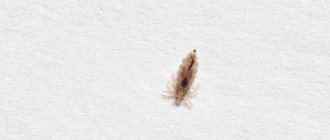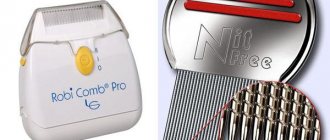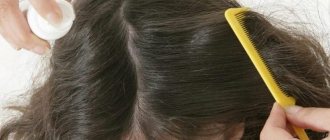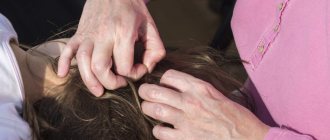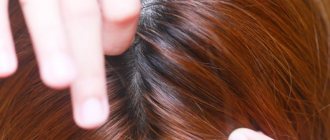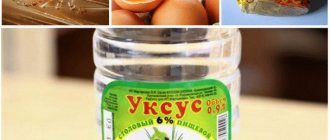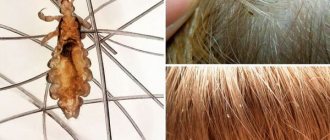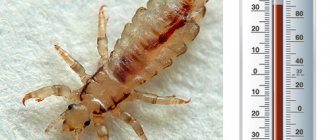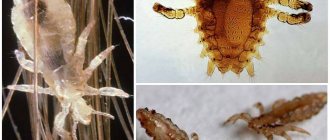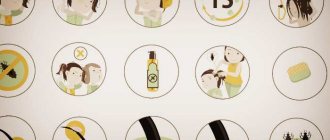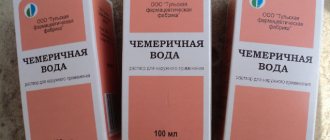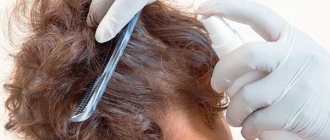Combing out lice and nits is most often used as an auxiliary method after exposing the hair to a medical or folk drug. This method allows you to comb out not only the parasites themselves, but also mechanically get rid of lice larvae - nits. Removing nits is more difficult, since the eggs are tightly attached to the hair, at its base. They are covered with a dense shell, which complicates the process of fighting parasites. In the fight against head lice, efficiency plays an important role. The average lifespan of a female is 40 days, however, during her life cycle she is able to leave offspring, which number in the hundreds of larvae.
Tools
The effectiveness of combing directly depends on the tool with which you are going to manipulate. The most popular ones in this regard are:
- crest;
- electric comb.
We recommend reading: a review of the best combs for lice and nits in humans.
The specificity of a special comb lies in the material of the teeth, their close distance from each other and the rigidity of the structure. This makes it easy to pass through the hair and comb out tightly adhered nits. The teeth of high-quality combs are laser-cut, which ensures thorough processing. The edges have a rounded shape, which prevents injury to the scalp. Metal combs have proven to be the best in this matter.
Manufacturers of products for head lice also sell a comb as a set. As a rule, such combs are of low quality, which affects the effectiveness of the procedure.
Attention! In addition to the material, combs differ in the length of the teeth. Combs with long teeth are designed for combing long hair, and combs with short teeth are for short haircuts.
Electric combs shock parasites with an electric shock. The discharge is of low power, it is harmless and practically unnoticeable by humans.
Using an ordinary comb, be it a massage brush (commonly known as a massage brush) or a comb, will not give a positive result. These types of brushes are designed primarily for untangling tangled hair; the bristles are too far apart from each other, which does not help comb out small enough lice and nits.
Prevention methods
Getting rid of lice is difficult, so much attention is paid to prevention. It comes down to maintaining personal hygiene. It is important to take into account that adults easily tolerate the problem, while children can withdraw into themselves, which is extremely dangerous in childhood. For the same reason, it cannot be argued that pediculosis is a disease of antisocial individuals, otherwise the child can simply hide the disease from adults
For prevention, you should be careful about overnight stays, for example, children's camps, health centers, school camps, hotels. If possible, do not use other people's towels, combs and hairpins. Linen is washed and changed regularly, and pillows and mattresses are taken out into the fresh air, especially in winter. It is enough to regularly wet clean the room.
Remedies for head lice
To achieve the best result, before combing, it is better to treat your hair with an anti-lice product. Recipes for some of them:
- Decoction of pomegranate and mint. The infusion can be prepared at home. To do this you will need a glass of pomegranate juice and a few mint leaves. Boil the resulting mixture for about 10 minutes, then let it brew. Cool to room temperature, rub into scalp and hair.
- Onion mask. To prepare it, you need a medium-sized onion and two egg yolks. The onion is finely chopped and mixed with the yolks. The mask is applied to the scalp and distributed over the entire length of the hair. It is better to cover your hair with a bag and a towel. Leave the mask on for a couple of hours, then rinse thoroughly. Wash your hair with regular shampoo.
- Among traditional medicine recipes, kerosene is often mentioned to combat lice and nits. However, this method can quite easily lead to a chemical burn or cause a severe allergic reaction.
- Treatment with vinegar solution. Considering that the solution will be applied directly to the scalp and hair, it is important that the vinegar used is no more than 9% concentration. Vinegar is mixed with water in a ratio of 1 part vinegar and 2 parts water. Then the hair is treated with the solution. Wrap your head in a towel and leave for 30 minutes. The maximum residence time with the solution is no more than an hour. Vinegar does not kill lice and nits, but is very effective in removing nits from hair.
- Hydrogen peroxide. It is able to influence the adhesive substance with which nits are attached to the hair and facilitate their separation from the hair. The solution is prepared by adding water in a ratio of 3 parts water and 1 peroxide. Cover your hair with a plastic bag. Apply to hair and leave for about half an hour.
Important point! Hydrogen peroxide has a lightening effect, so it is important not to exceed the dosage and treatment time.
The pharmaceutical industry offers a wide range of products for head lice:
- shampoos;
- sprays;
- ointments;
- solutions, etc.
Such products can destroy all living lice in 15–20 minutes and facilitate the process of further combing out. However, they are ineffective against nits.
What do you need to know?
There are other ways to get lice out of your hair. Although they are popular, they are not safe:
To completely eliminate lice, it is important to comb out the parasites regularly, for at least a month, no matter what method of destruction is chosen. The methods listed in the article are some of the most effective.
Preparing for brushing
The process of combing out nits requires careful preparation, the quality of which determines the likelihood of re-infection and the spread of parasites. Missing just one individual can quickly lead to a resurgence of the parasite population.
Before combing you need to:
- Cover your shoulders and place light paper or cloth on the floor. Newspaper is not suitable for these purposes, since it will be difficult to notice insects against its background. If fallen lice are discovered, they must be destroyed immediately.
- The person who will process the product should protect themselves from infection: wear gloves, remove hair, and put on a light-colored robe.
- Periodically rinse the comb in an alcohol-containing solution or vinegar and remove dead insects from the comb.
- It is better to prepare a workplace near a window or choose a room with good artificial lighting.
- Pre-apply balm to your hair, which makes strands easier to comb.
Removing pubic lice
These insects are blood-sucking, with claws and increased tenacity they resemble small crabs. They hold triangular hairs in the pubic and anal areas, armpits, chest and abdomen. They cannot live on the head, since their limbs are not designed to move along round hairs.
Usually insects are transmitted through sexual intercourse, but infection can also occur from the use of other people's things:
- bathrobes;
- towels;
- washcloths used in public baths and hotels.
If eyebrows and eyelashes are affected, lice are removed manually or with tweezers. Hair on the pubic area and other parts of the body must be shaved. Previously, mercury ointment was an effective means of eliminating pubic parasites, but in 1998 its production was discontinued due to a number of contraindications. In case of insect bites, the affected area must be disinfected with any available means.
Instructions for use
To effectively remove lice and nits from hair, you must adhere to the following algorithm of actions:
- If possible, pre-treat your hair with a head lice remedy. Both pharmaceutical products and traditional medicine are suitable for this.
- Do not dry your hair, dry it slightly so that it remains moist. So, parasites are more noticeable.
- Hair should be combed with an ordinary comb and divided into strands. If you brush yourself, it will be convenient to tie your hair in a high ponytail and then pull out thin strands from it.
- It is better to start combing from temple to temple, then proceed to the back of the head. If you have bangs, they should be processed last.
- Comb from roots to ends, slowly running the comb through the hair. Pin up treated hair.
- The strands must be taken small so that they can be easily combed with a comb.
- You need to comb the strand on both sides, then rinse the comb with the prepared solution and remove insects from the tool.
- After processing, all instruments and tissues must also be “neutralized.” Fabrics should be boiled for several minutes, shaken well outside and ironed.
- The comb must also be boiled and cleaned after each treatment.
- Be sure to thoroughly clean the house and pay close attention to upholstered furniture. It is better to wash bed linen and clothes at high temperatures.
- If household items on which insects could remain cannot be washed, then they should be packed in plastic bags and left in this condition for 14 days. A living individual cannot exist without food for more than 6 days, so in 2 weeks without food both lice and nits die.
Elimination of body lice
This type of lice lives on bedding and clothing, hiding in folds and seams. This is how they gain access to the body and drink blood. After linen lice bites, the skin itches, preventing a person from sleeping, and irritation appears.
If you have body lice, how do you get them out? To kill insects, disinfection is needed - chemical or thermal. It is intended for mattresses, bed linen, upholstered furniture and clothing. Disinfection involves:
- washing in hot water (boiling);
- freezing outside (in winter) or in a freezer;
- steam treatment;
- exposure to direct sunlight;
- placing clothes in a vacuum, for example, in a plastic bag;
- spraying with Medifox or A-steam.
The final stage is the disinfestation of housing. Usually after such procedures the lice disappear.
Advantages and disadvantages
The combing procedure has both its pros and cons. Each case is individual, so based on the information received, it will be easier to choose one or another means of combating head lice. Hair combing has the following advantages over other means of combating head lice:
- This method will not cause an allergic reaction in the body, which is quite possible when using special shampoos or other chemical products. It also has no age restrictions and is harmless to use even for the smallest children.
- There is no chance of getting a chemical burn.
- Unlike chemical remedies for head lice, the comb has a shelf life throughout its service life and can be used even after several years.
- The comb can be used repeatedly.
- The special design of the comb allows you to comb your hair without damaging the scalp or tearing out hair.
This method also has a number of disadvantages:
- Combing is a very labor-intensive and time-consuming process. Even a single procedure takes at least an hour; the procedure must be repeated for at least seven days every day. When other remedies against head lice require less time and effort.
- If you have to comb yourself, without resorting to the help of strangers, the procedure becomes much more complicated.
- The cost of a good quality comb is much higher than the cost of regular lice shampoo.
Important! If your choice is mechanical treatment for head lice, namely combing, you should remember that the result of the fight will depend not only on the quality of the tool, but also on your dedication and diligence.
Precautionary measures
When using oil compositions, safety rules should be followed. Because they are toxic, which can cause harm to the body weakened by parasites. The following rules must be adhered to:
- It is necessary to use drugs that have not expired from well-known manufacturers.
- Care must be taken to ensure that the components do not enter the esophagus. Since they can lead to poisoning, stomach pain, vomiting, and hallucinations.
- You should follow the recommendations in the recipe. Since a high concentration can lead to burns.
- Essential substances should only be used in a diluted state.
- It is necessary to ensure that the composition does not come into contact with the mucous membrane of the eyes.
- It is forbidden to carry out treatment on an empty stomach. Inhaling essential substances can make you feel worse and cause dizziness.
We recommend reading: why lice are dangerous, what diseases they carry.
Important! If, after applying the mixture, an unbearable burning sensation appears on your head, then you need to quickly wash it off with warm water.
Frequency of combing
Having chosen this method of combating lice and nits, you should be patient. The parasites will not disappear after the first treatment; repeated daily treatments will be required to completely eliminate lice and nits.
Moreover, the number of repetitions subsequently depends on the quality and thoroughness of the very first combing. This approach is primarily due to the fact that even one nit missed during combing can multiply very quickly and prolificly.
Therefore, it is extremely important not to interrupt the process and complete the procedure until all parasites are completely destroyed.
For preventive purposes, it would be useful to carry out treatment once a week. This applies primarily to children, who are especially susceptible to infection. After the course of the procedure, a follow-up examination should be done a week later.
Even if the nit went unnoticed, after such a period of time the louse will hatch from it and it will be clear whether errors were made during processing and whether the procedure needs to be repeated again until the parasite population increases.
The times when the discovery of head lice meant cutting your hair to zero are behind us. However, despite the development of modern medicine and improved living conditions, pediculosis still exists. And, as before, it is not customary to talk about this trouble out loud. The main thing in the treatment of pediculosis is timeliness, scrupulousness, diligence and an integrated approach to treatment.
Effective remedies against lice and nits:
- how well Medifox helps against lice and nits;
- composition of the drug Full Marks (fullmarks), reviews;
- review of Nit Free lice products;
- instructions for use of Pediculen ultra shampoo for pediculosis;
- spray Paranit for lice and nits, precautions;
- the best remedies for lice and nits in children.
Do lice live on colored hair?
Many women are convinced that regular dyeing helps get rid of lice. But practice shows that parasites feel equally good on clean or dirty, curly or straight, natural or dyed hair.
The chemicals contained in certain types of hair dyes do have a negative effect on lice, but this requires direct exposure. If the infection occurs after dyeing, then the parasites will live and multiply in the same way as on natural hair. Lice feed on blood. The chemicals contained in paints do not penetrate into the human bloodstream, otherwise we would experience unpleasant side effects after painting. Thus, changing hair color has no effect on lice.
Medicinal mixtures
This option can remove parasites much faster, since a combination of several different ingredients will have a complex effect. Not all oils can be mixed, and before use, you should consult a doctor to determine compatibility with your body. The mixture needs to be applied less often and in a smaller volume, the more the overall effect will become stronger and therefore less mixture will be needed.
Oil compositions
The most popular complex products include the following tandems:
- 20 parts tea tree oil to 4 parts clove oil;
- equal ratio of lavender and olive oil;
- burdock with bergamot in a ratio of 1 to 1;
- in equal parts brome and eucalyptus;
- children under 7 years old can use a composition of 30 ml of sunflower oil, to which 3 drops are added. lavender, lemon, rosemary, tea tree;
- Children of school age are allowed to use the following complex: 30 ml of castor with 3 drops. tea tree oils, rosemary, thyme.
